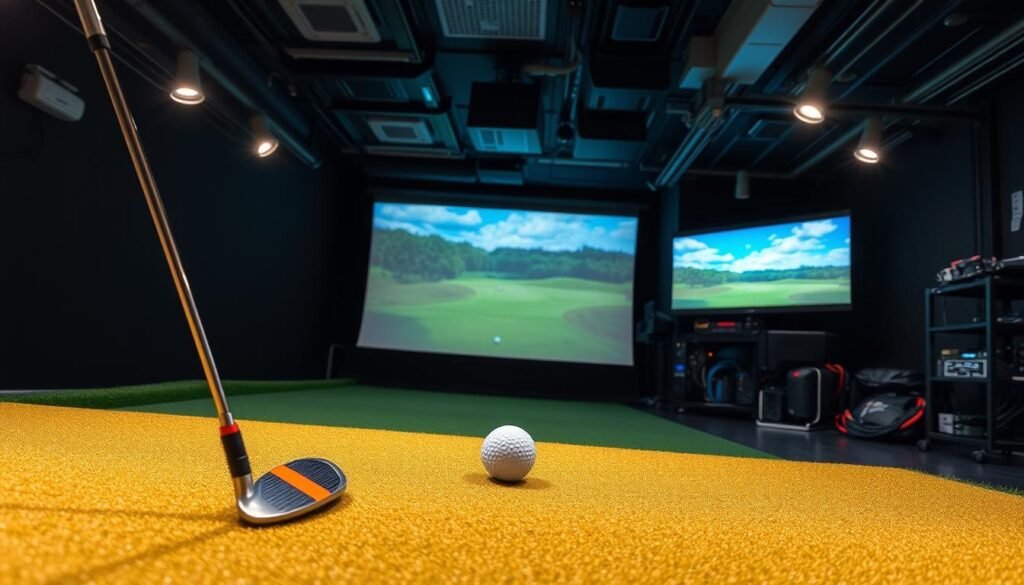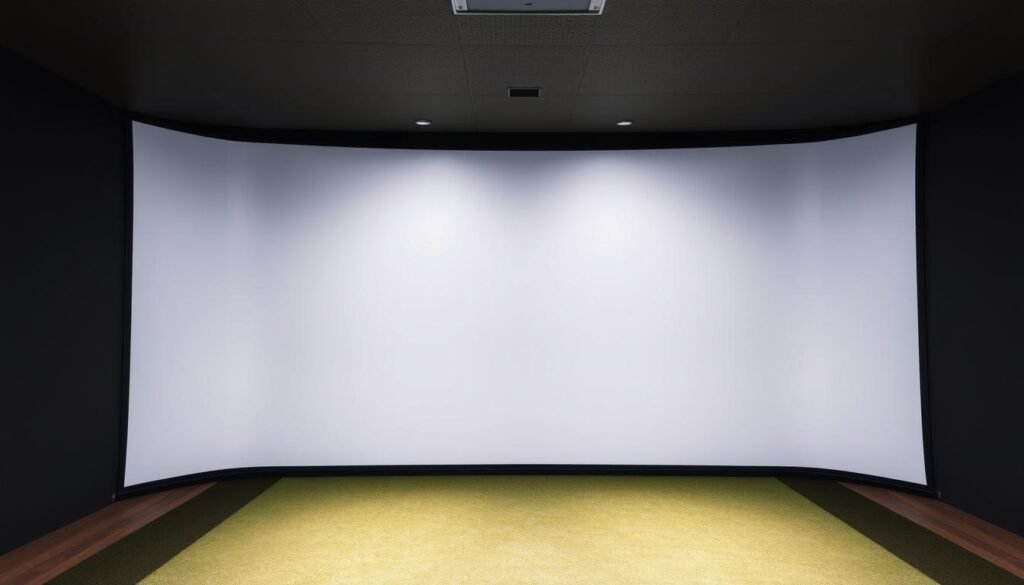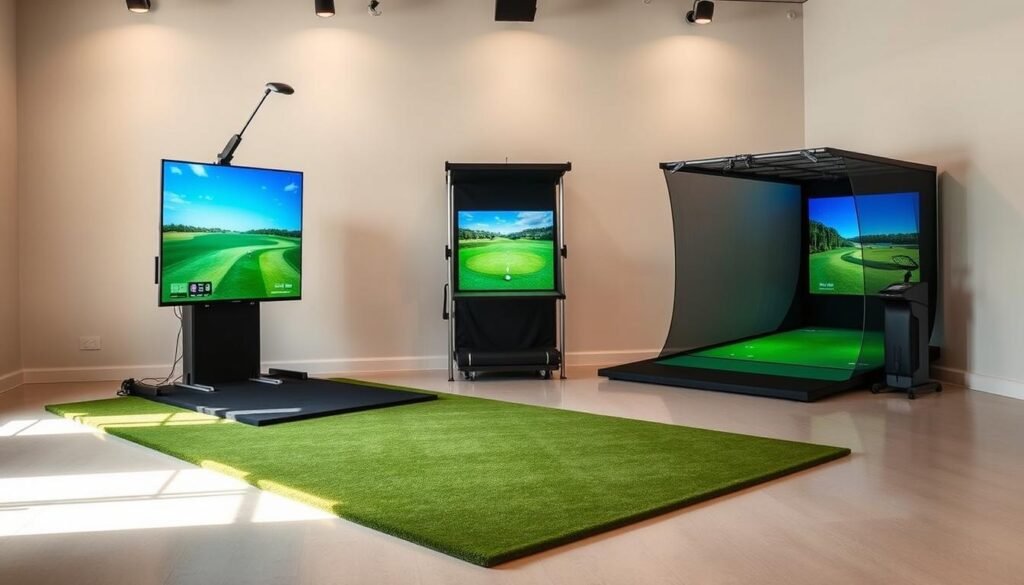Investing in a high-tech practice space for your swing isn’t just about price tags—it’s about lasting value. Whether you’re eyeing a $5,000 starter kit or a $20,000+ pro-level system, durability matters. But here’s the catch: even premium components like Uneekor tracking systems or Carl’s impact screens don’t guarantee endless use.
Your setup’s longevity hinges on four pillars: build quality, usage habits, care routines, and environmental control. A SkyTrak monitor paired with a DIY enclosure might serve you well for years—if stored properly. Yet daily sessions in a dusty garage? That’s a different story.
Top-tier screens withstand 15,000+ strikes, while budget mats fray faster. Projectors dim over time, and sensors need recalibration. The sweet spot? Most systems deliver 5-7 years of peak performance with smart maintenance. But components age at different rates—like car parts needing staggered replacements.
Key Takeaways
- Premium components often outlast budget options by 2-3 years
- Impact screens and mats face the most wear during practice
- Climate-controlled spaces prevent tech degradation
- Annual maintenance can extend lifespan by 30%
- Warranty terms reveal manufacturer confidence in durability
Understanding the Lifespan of Your Golf Simulator
Your setup operates like a luxury car—every part must work in harmony for peak performance. While flashy tech grabs attention, true durability stems from how all elements interact over years of practice.
Defining Simulator Durability
Durability isn’t just about individual parts. It’s how screens, sensors, and software collaborate. Premium impact screens handle 15,000+ strikes, but pairing them with thin mats creates imbalance. Think of your system as a chain—the weakest link dictates its lifespan.

The Role of Technology and Materials
Modern sensors self-calibrate, while advanced polymers in screens resist yellowing. Yet even top-tier tech falters if exposed to humidity or dust. Newer systems use modular designs, letting you swap worn parts without replacing entire setups.
Materials matter most in high-impact zones. Carl’s Premium screens use triple-layer fabrics, while budget options fray after 5,000 swings. Software updates can revive older monitors, but outdated connectors might limit compatibility.
Plan for staggered upgrades. Track wear patterns—mats fray first, projectors dim gradually. Smart maintenance keeps your system evolving instead of aging.
Also read: Golf Simulator: The Ultimate Beginner’s Guide
Key Factors Affecting Simulator Longevity
The lifespan of your golf tech hinges on two critical elements: what you buy and how you treat it. Premium components paired with smart care routines create a practice space that evolves with your game rather than crumbling under it.

Component Quality: Impact Screens, Mats, and Monitors
Carl’s Premium models set the standard, handling 15,000+ strikes before showing wear. Budget screens? They might split after 5,000 swings. Your launch monitor becomes the system’s backbone—SkyTrak units often deliver decade-long service when shielded from temperature swings.
Hitting mats reveal wear fastest. Premium versions with swappable strike zones triple their usable life. Projectors dim gradually, but quality bulbs maintain brightness for 8,000+ hours.
Usage Frequency and Maintenance Practices
Daily sessions accelerate wear patterns. Rotate your mat monthly to distribute impact zones. Wipe sensors weekly with microfiber cloths—dust buildup skews launch data.
Screen tension matters. Properly stretched surfaces absorb energy evenly, preventing premature tears. Store clubs away from the enclosure to avoid accidental strikes during setup changes.
How Long Will A Golf Simulator Last?
Industry professionals shed light on maximizing your practice setup’s durability through strategic choices. Their findings reveal surprising patterns about component synergy and smart investment thresholds.
Insights from Industry Experts
Leading tech analysts emphasize regular calibration cycles. “Systems using SkyTrak monitors paired with Carl’s enclosures often deliver 6+ years of precision,” notes simulator engineer Mark Tessen. Proper climate control proves critical—units in temperature-stable spaces outlast garage setups by 40%.

High-end configurations aren’t always better. Uneekor’s $20,000 packages typically last 8-10 years, but require annual $500 sensor upgrades. Mid-range solutions balance costs better—most users replace mats and screens once before upgrading the launch monitor.
Comparing Different Simulator Setups
| Configuration | Initial Cost | Avg Lifespan | Best For |
|---|---|---|---|
| Entry-Level | $3,000-$5,000 | 4-5 years | Casual players |
| Mid-Range | $8,000-$12,000 | 6-7 years | Serious practice |
| Premium | $18,000+ | 8-10 years | Commercial use |
Budget systems wear unevenly—their screens often fail first. Premium packages distribute wear better but risk tech obsolescence. The sweet spot? Mid-tier setups with modular designs let you replace worn parts without full overhauls.
Your environment plays a bigger role than price tags. Humidity-controlled spaces preserve sensors 30% longer than basements. Rotate hitting mats quarterly—this simple habit extends their life by 18 months on average.
Maximizing Longevity Through Proper Setup and Maintenance
Your golf setup’s lifespan depends as much on daily care as on initial quality. Strategic installation and proactive upkeep form the foundation for preserving your equipment’s precision and performance over thousands of swings.
Installation Tips for Optimal Performance
Start with screen tension—the cornerstone of durability. Use adjustable bungees and zip ties to create uniform pressure across all sides of your impact screen. This prevents stress points and distributes ball strikes evenly.
Position your enclosure away from direct sunlight and moisture sources. Even 70°F with 50% humidity helps sensors stay calibrated. Leave 18-24 inches behind the screen for energy absorption during ball strikes.
Maintenance Routines and Upkeep Strategies
Rotate hitting mats every 60-90 days to spread wear patterns. Clean launch monitor lenses weekly with microfiber cloths—dust accumulation skews data by up to 12% according to recent tests.
Ball choice directly affects screen life. Avoid marked or scuffed balls—their rough surfaces accelerate fabric degradation. High-spin models with soft covers cause 3x more abrasion than firmer alternatives.
| Ball Type | Cover Hardness | Spin Level | Screen Wear |
|---|---|---|---|
| High-Spin Soft Cover | Low | Extreme | Rapid |
| Mid-Spin Hybrid Cover | Medium | Moderate | Average |
| Low-Spin Hard Cover | High | Minimal | Slow |
Flip screens vertically when central wear appears, but never reverse front-to-back. Address tears immediately with repair kits—small fixes prevent costly replacements. Store clubs separately to avoid accidental screen contact during setup changes.
Creating the Ideal Environment for Long-Lasting Use
Your practice space’s layout acts as the foundation for equipment longevity—ignore structural details, and even premium tech falters. Proper planning transforms spare rooms or garages into durable training zones that protect your investment.
Space Planning and Structural Considerations
Start with dimensions. While 10’x10’ areas work, 12-16’ widths prevent club dings and let you swing freely. Ceiling height matters most—measure from floor to the lowest obstruction. Nine feet clears most drivers, but vaulted spaces need beam-to-floor checks.
Wall materials dictate protection needs:
- Wood panels: Attach nets or padding directly
- Drywall/plaster: Add impact-resistant barriers first
- Concrete: Use foam tiles to dampen ball noise
Insulation proves critical in detached spaces. Garages and sheds require vapor barriers to stop condensation from frying sensors. Maintain 50-80°F temperatures—extremes warp projector lenses and mat surfaces.
Plan electrical outlets and ventilation early. USB ports near the hitting zone simplify monitor setups. Ceiling-mounted fans prevent heat buildup without occupying floor space. Structured cabling keeps tripping hazards away from your swing path.
Also read: How Much To Have A Golf Simulator Installed?
Evaluating Costs Against Long-Term Benefits
Smart financial planning transforms your practice setup from expense to asset. Crunching numbers reveals hidden savings that compound over time—if you play your cards right.
Investment Versus Savings on Green Fees
That $5,000 entry-level system equals 83 rounds at local courses. But play four weekly sessions? You’ll recoup costs in five months while avoiding $12,688 in annual fees. Add driving range savings, and your break-even point shrinks faster than a downhill putt.
Premium packages demand bigger upfront commitments but unlock commercial potential. Host virtual tournaments or offer lessons to offset costs. One Michigan facility reports $18,000 annual income from simulator rentals—enough to fund annual tech upgrades.
Budgeting for Future Upgrades and Replacements
Treat your setup like a car maintenance schedule. Set aside monthly funds for:
- Mat replacements ($200-$500 every 2-3 years)
- Screen swaps ($300-$800 every 3-5 years)
- Software licenses ($100-$300 annually)
Allocate 15% of your initial investment yearly for improvements. This cushions against tech obsolescence while letting you adopt new features. Modular systems shine here—swap sensors without rebuilding entire enclosures.
| Expense Type | Frequency | Typical Cost |
|---|---|---|
| Mat Replacement | Biennial | $350 |
| Software Updates | Annual | $200 |
| Sensor Calibration | Semi-Annual | $150 |
Financial advisor Lisa Grewal notes: “Simulator owners who budget for upgrades maintain 73% longer system relevance than those who don’t.” Your future self will thank you when next-gen tech arrives.
Enhancing Simulator Performance with Advanced Features
Tech advancements transform basic practice tools into precision instruments. The right upgrades keep your system relevant while minimizing wear from outdated components.
Why Modern Tracking Matters
Newer launch monitors like SkyTrak+ deliver tour-level accuracy with dual Doppler radar. These systems capture spin rates within 2% of pro-grade results, reducing guesswork during swing analysis. Built-in infrared sensors eliminate manual recalibration—a common pain point with older models.
Software compatibility determines long-term value. Platforms like GSPro and TGC 2019 receive regular updates, ensuring your monitor stays synced with new courses and features. Avoid proprietary systems that lock you into stagnant ecosystems.
- High-speed cameras track clubface angles at 10,000 fps
- Infrared grids map ball flight without physical contact
- Cloud storage preserves swing data across devices
Your computer’s GPU becomes the unsung hero. Aim for NVIDIA RTX 3060 or better to handle 4K simulations. Weak processors force software compromises that accelerate component obsolescence.
Smart integrations future-proof your setup. Voice-controlled lighting adjusts ambient conditions mid-session, while mobile apps stream data to coaches instantly. These features maintain engagement, making ongoing maintenance feel worthwhile.
Conclusion
Your indoor golf experience thrives when quality components meet disciplined care. Choosing durable mats and responsive tracking systems sets the stage, but daily habits determine whether your setup ages gracefully or deteriorates prematurely. Rotate impact zones, monitor humidity levels, and protect screens from UV exposure—these small acts compound over time.
Owners who treat their space as evolving ecosystems reap rewards. Regular software updates keep launch monitors relevant, while modular designs allow swapping worn parts without full replacements. Budget for periodic upgrades like screen refreshes or projector bulb swaps to maintain peak performance.
The best golf practice tools balance innovation with practicality. Whether perfecting your swing or hosting virtual tournaments, a well-maintained simulator becomes a long-term ally. Invest in foundational elements first—climate control, proper spacing, and impact-resistant materials—then build outward as your skills and needs grow.